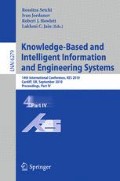Abstract
This paper proposes a method to recognize dialect on personal computers. Proposal method pays attention to dialects’ emotion content of speakers. Dialects have much emotional expression compared with standard dialect. Therefore, this system judges sentences including some dialects using Emotion Judgment System inputting dialects as standard dialects. Emotion Judgment System answers wrong emotion as standard dialect if inputs include some dialect. This paper treats dialect used in Nagano prefecture, Japan. This paper shows that using speaker’s emotion can solve the disambiguation of the dialect and the standard dialect.
Access this chapter
Tax calculation will be finalised at checkout
Purchases are for personal use only
Preview
Unable to display preview. Download preview PDF.
References
Yarowsky, D.: Word-sense disambiguation using statistical models of Roget’s categories trained on large corpora. In: Proc. COLING 1992, pp. 454–460 (1992)
Yarowsky, D.: Unsupervised word sense disambiguation rivaling supervised methods. In: Proc. ACL 1995, pp. 189–196 (1995)
Veronis, J., Ide, N.: Word sense disambiguation with very large neural networks extracted from machine readable dictionaries. In: Proc. COLING 1992, pp. 359–365 (1992)
Noriyuki, O., et al.: An Association Method Using Concept-base. In: Apolloni, B., Howlett, R.J., Jain, L. (eds.) KES 2007, Part I. LNCS (LNAI), vol. 4692, pp. 604–611. Springer, Heidelberg (2007)
Seiji, T., et al.: Proposal of Method to Judge Speaker’s Emotion Based on Association Mechanism. In: Apolloni, B., Howlett, R.J., Jain, L. (eds.) KES 2007, Part I. LNCS (LNAI), vol. 4692, pp. 847–854. Springer, Heidelberg (2007)
Taku, K., et al.: Applying Conditional Random Fields to Japanese Morphological Analysis. In: Proceedings of the 2004 Conference on Empirical Methods in Natural Language Processing (EMNLP 2004), pp. 230–237 (2004)
The National Language Research Institute, Tokyo, Japan: Texts of Tape-Recorded Conversation In Japanese Dialects, vol. 1 (1978)
Author information
Authors and Affiliations
Editor information
Editors and Affiliations
Rights and permissions
Copyright information
© 2010 Springer-Verlag Berlin Heidelberg
About this paper
Cite this paper
Okumura, N. (2010). Dialect Recognition Method Using Emotion Judgment. In: Setchi, R., Jordanov, I., Howlett, R.J., Jain, L.C. (eds) Knowledge-Based and Intelligent Information and Engineering Systems. KES 2010. Lecture Notes in Computer Science(), vol 6279. Springer, Berlin, Heidelberg. https://doi.org/10.1007/978-3-642-15384-6_6
Download citation
DOI: https://doi.org/10.1007/978-3-642-15384-6_6
Publisher Name: Springer, Berlin, Heidelberg
Print ISBN: 978-3-642-15383-9
Online ISBN: 978-3-642-15384-6
eBook Packages: Computer ScienceComputer Science (R0)

